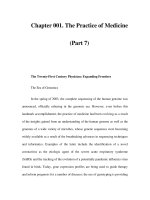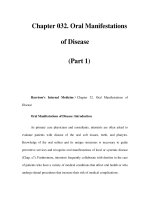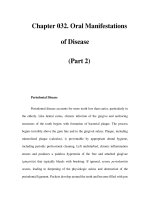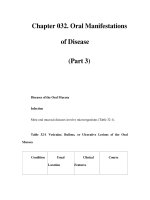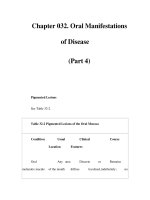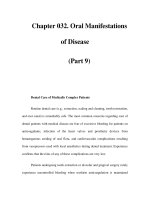Chapter 032. Oral Manifestations of Disease (Part 10) docx
Bạn đang xem bản rút gọn của tài liệu. Xem và tải ngay bản đầy đủ của tài liệu tại đây (65.18 KB, 5 trang )
Chapter 032. Oral Manifestations
of Disease
(Part 10)
Aging and Oral Health
While tooth loss and dental disease are not normal consequences of aging, a
complex array of structural and functional changes occurs with age that can affect
oral health.
Subtle changes in tooth structure (e.g., diminished pulp space and volume,
sclerosis of dentinal tubules, altered proportions of nerve and vascular pulp
content) result in diminished or altered pain sensitivity, reduced reparative
capacity, and increased tooth brittleness. In addition, age-associated fatty
replacement of salivary acini may reduce physiologic reserve, thus increasing the
risk of xerostomia.
Poor oral hygiene often results when vision fails or when patients lose
manual dexterity and upper extremity flexibility. This is particularly common for
nursing home residents and must be emphasized since regular oral cleaning and
dental care has been shown to reduce the incidence of pneumonia.
Other risks for dental decay include limited lifetime fluoride exposure and
preference by some older adults for intensely sweet foods when taste and olfaction
wane.
These factors occur in an increasing proportion of persons over age 75 who
retain teeth that have extensive restorations and exposed roots. Without assiduous
care, decay can become quite advanced yet remain asymptomatic. Consequently,
much or all of the tooth can be destroyed before the process is detected.
Periodontal disease, a leading cause of tooth loss, is indicated by loss of
alveolar bone height. Over 90% of Americans have some degree of periodontal
disease by age 50.
Healthy adults who have not experienced significant alveolar bone loss by
the sixth decade do not typically develop significant worsening with advancing
age.
Complete edentulousness with advanced age, though less common than in
previous decades, is still present in approximately 50% of Americans age ≥85.
Speech, mastication, and facial contours are dramatically affected. Edentulousness
may also worsen obstructive sleep apnea, particularly in those without symptoms
while wearing dentures.
Dentures can improve speech articulation and restore diminished facial
contours. Mastication is restored less predictably, and those expecting dentures to
improve oral intake are often disappointed.
Dentures require periodic adjustment to accommodate inevitable
remodeling that leads to a diminished volume of the alveolar ridge. Pain can result
from friction or traumatic lesions produced by loose dentures.
Poor fit and poor oral hygiene may permit candidiasis to develop. This may
be asymptomatic or painful and is indicated by erythematous smooth or granular
tissue conforming to an area covered by the appliance.
Further Readings
Durso SC: Interaction with other health team members in caring for elderly
patients. Dent Clin N Am 49:377, 2005 [PMID: 15755411]
Little JW et al (eds):
Dental Management of the Medically Compromised
Patient, 6th ed. St. Louis, Mosby, 2002
Regezi JA, Sciubba JJ: Oral Pathology: Clinical Pathologic Correlations
,
4th ed. Philadelphia, Saunders, 2002
Spahr A et al: Periodontal i
nfection and coronary heart disease. Role of
periodontal bacteria and importance of total pathogen burden in the coronary event
and periodontal disease (CORODONT) study. Arch Intern Med 166:554, 2006
[PMID: 16534043]
Woo SB et al: Systematic Review: Bis
phosphonates and osteonecrosis of
the jaws. Ann Intern Med 144:753, 2006 [PMID: 16702591]
